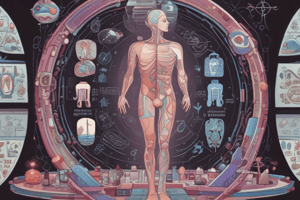Podcast
Questions and Answers
Explain the difference in anti-blood clotting mechanism between apixaban and acetylsalicylic acid (aspirin).
Explain the difference in anti-blood clotting mechanism between apixaban and acetylsalicylic acid (aspirin).
Apixaban primarily impacts the coagulation cascade by inhibiting specific clotting factors, while aspirin targets platelet function and aggregation via COX enzymes.
Why are people at higher risk of bleeding when combining apixaban with medicinal products that inhibit CYP3A4 and P-glycoproteins?
Why are people at higher risk of bleeding when combining apixaban with medicinal products that inhibit CYP3A4 and P-glycoproteins?
Combining apixaban with drugs that inhibit CYP3A4 or P-glycoprotein can lead to higher apixaban levels in the body, slowing down the breakdown of apixaban and prolonging its anticoagulant action, potentially increasing the risk of bleeding.
How does apixaban work as a directly acting anticoagulant?
How does apixaban work as a directly acting anticoagulant?
Apixaban works as a directly acting anticoagulant, making it easier for the blood to flow through the body and preventing blood clots.
What is a common side effect associated with the mechanism of action of apixaban?
What is a common side effect associated with the mechanism of action of apixaban?
What is P-glycoprotein and how does it relate to the action of apixaban?
What is P-glycoprotein and how does it relate to the action of apixaban?
What is the mechanism of action of angiotensin II receptor blockers (ARBs) like valsartan?
What is the mechanism of action of angiotensin II receptor blockers (ARBs) like valsartan?
What are the main indications for the use of angiotensin II receptor blockers (ARBs) like valsartan?
What are the main indications for the use of angiotensin II receptor blockers (ARBs) like valsartan?
How can the side-effect of dizziness from valsartan's mechanism of action be explained?
How can the side-effect of dizziness from valsartan's mechanism of action be explained?
What is the difference in mechanism of action between ACE inhibitors and ARBs in the context of treating hypertension?
What is the difference in mechanism of action between ACE inhibitors and ARBs in the context of treating hypertension?
Explain how ARBs like valsartan lead to increased urinary water loss and lowered blood pressure.
Explain how ARBs like valsartan lead to increased urinary water loss and lowered blood pressure.
Flashcards are hidden until you start studying




